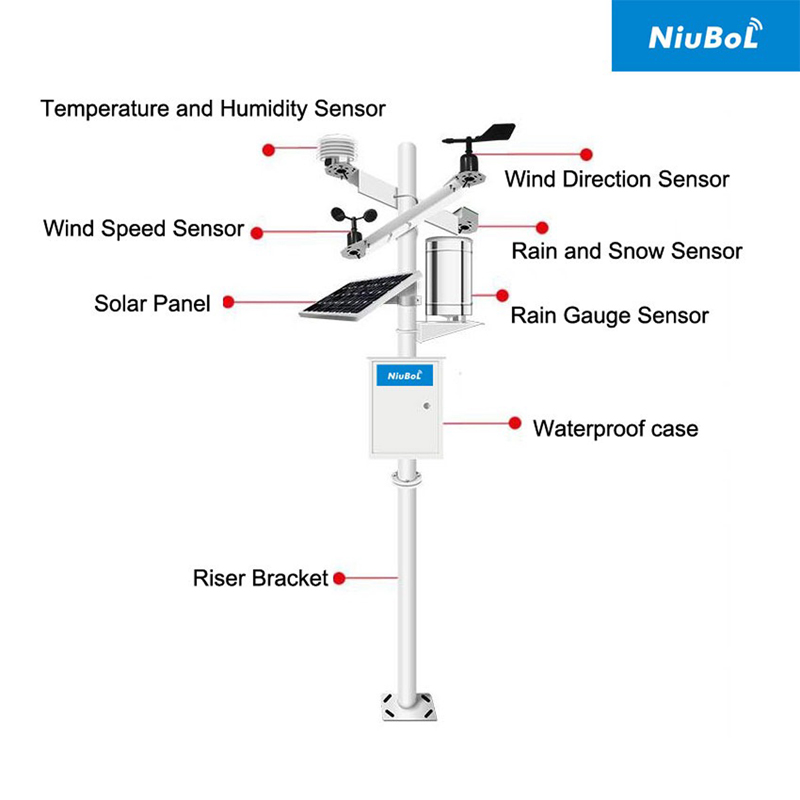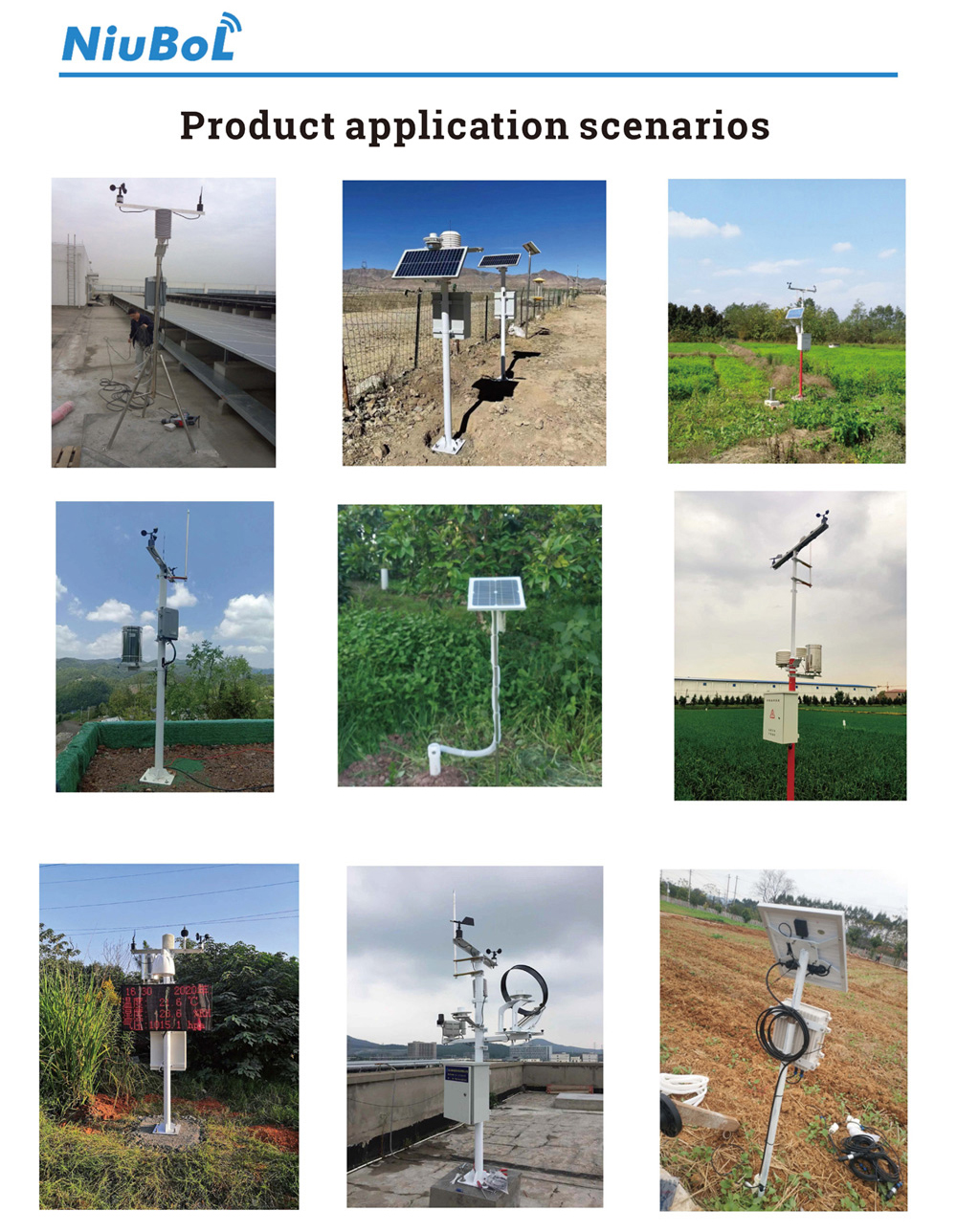

— Products —
 Consumer hotline +8618073152920
Consumer hotline +8618073152920 WhatsApp:+8615367865107
Address:Room 102, District D, Houhu Industrial Park, Yuelu District, Changsha City, Hunan Province, China
All products
ambient weather station is a key facility dedicated to the collection, analysis and transmission of meteorological and environmental data. It collects and monitors data on various indicators of the environment such as the atmosphere, water and soil, including temperature, humidity, wind speed, precipitation, air quality, radiation, etc. in real time through various sensors and instruments. These data can help understand and assess information on regional climate change, envir···
Tel/WhatsApp:+8615367865107
Email:Arvin@niubol.com +Nearly 100 partner company in more than 68 countries. We are committed to providing high-quality, practical products to meet your needs and help you solve problems.Product Details
An ambient weather station is a key facility dedicated to the collection, analysis and transmission of meteorological and environmental data. It collects and monitors data on various indicators of the environment such as the atmosphere, water and soil, including temperature, humidity, wind speed, precipitation, air quality, radiation, etc. in real time through various sensors and instruments. These data can help understand and assess information on regional climate change, environmental pollution and ecological conditions, and provide a scientific basis for environmental management and protection.
 |  |  |  |
| Portable weather stations | Rain gauge | Ultrasonic weather stations | Pyranometer(Solar Radiation Sensor) |
In addition, environmental meteorological stations can provide important data support for weather forecasting and disaster warning systems, providing accurate weather forecasting and disaster warning information by monitoring atmospheric parameters and meteorological change trends. In terms of environmental impact assessment, by monitoring and analyzing environmental parameters, environmental meteorological stations can assess the degree of impact and feasibility of a project on the environment, and put forward reasonable environmental protection measures and management suggestions.
At the same time, the data from environmental weather stations are also an important basis for climate research and environmental science fields. Through long-term data collection and analysis, it can reveal the cyclical changes, long-term trends and sudden change events of the climate, and provide references for the construction of climate models and predictions.
In addition, environmental weather stations also have social service functions, providing weather information and environmental knowledge for the public and helping people rationally arrange their lives and travel.
In conclusion, environmental weather stations play an important role in environmental protection, climate research, weather forecasting and social services, providing important support for sustainable development and improving the quality of life.
| Measured | Measuring range | Resolution | Precision |
| Humidity | 0~100%RH | 0.1%RH | ±0.5℃ |
| Temperature | -40~80℃ | 0.1℃ | ±5%RH |
| Atmospheric pressure | 10~1200hPa | 0.1hPa | ±1.5hPa |
| Soil temperature | -40~80℃ | 0.1℃ | ±0.5℃ |
| Soil Humidity (moisture) | 0-100%RH | 0.1%RH | ±5%RH |
| Conductivity | 0-10000us/cm | 1us/cm | ±5% |
| Wind speed | 0~70m/s | 0.1m/s | ±(0.3+0.03V)m/s |
| wind direction | 0~360° | - | ±3° |
| Noise | 30~130dB | - | - |
| Illuminance | 0-200000Lux | - | ±7% |
| Rainfall | 0-4mm/min | 0.2mm | ±4% |
| PM2.5/PM10 | 0-2000μg/m3 | - | ±15% |
| Solar radiation | 0~2000W/m2 | - | ≤5% |
| CO2 | 0~2000ppm | 1ppm | ±7% |
| Supply mode | 220V | DC12-24V | solar power optional |
 |  |  |  |  |
| Anemometer Wind Speed sensor | Wind direction sensor | Tipping bucket rain gauge sensor | Tipping bucket rain gauge sensor | Piezoelectric Rain Gauge |
 |  |  |  |  |
| Atmospheric Temperature Humidity air pressure Sensor | ultrasonic wind speed and direction sensor | 5 in1 Ultrasonic Weather Station Sensor | 6 in1 Ultrasonic Weather Station Sensor | 7 in1 Ultrasonic Weather Station Sensor |
 |  |  |  |  |
| Solar Radiation Sensor | Solar Radiation Sensor | Photosynthetically Active Radiation Sensor; | illumination sensor | Ultrasonic Snow Depth Sensor |
 |  |  |  |  |
| Noise measurement sensor | Carbon dioxide(CO2) sensor | PM2.5 and PM10 sensors | Visibility sensors | Soil Moisture Temperature sensor |
An Ambient Weather Station is a comprehensive weather monitoring device that typically includes multiple sensors to provide comprehensive weather data. While specific models may vary, the following sensors are typically included:
1. Temperature sensor: measures the temperature of the ambient air.
2. Humidity sensor: monitors the relative humidity of the air.
3. Wind speed sensor: Used to measure wind speed and usually designed as a rotating structure such as a wind cup or propeller type.
4. Wind direction sensor: to determine the direction of the wind, commonly a device with a wind vane.
5. Rain gauge: records the amount of precipitation, may be a tipping bucket or other type of sensor.
6. Barometric sensors: measure atmospheric pressure, useful for weather forecasting.
7. Solar radiation sensors: assess the intensity of total, direct or scattered radiation.
8. Ultraviolet sensors: measure the intensity of ultraviolet light, which is particularly important for outdoor activities and skin protection.
9. Light level sensor: detects the intensity of ambient light, which has an important effect on plant growth, for example.
10. Soil temperature and humidity sensor (optional): monitors the temperature and humidity of the soil, especially useful for gardening and agriculture.
11. Evaporation sensor (in some advanced systems): for hydrological monitoring.
12. Indoor environment sensor: monitors indoor temperature and humidity.
The Ambient Weather station may also be equipped with a data collector to collect data from each sensor and transmit it wirelessly or wired to a display unit or upload it to the cloud for remote monitoring and analysis.
Ambient Weather Station is a weather monitoring device, which mainly consists of a main console and multiple sensors. The sensors are usually installed outdoors and can measure and record temperature, humidity, barometric pressure, wind speed, wind direction, precipitation and other meteorological data, while the main console is responsible for displaying and recording these data.
1. Sensor Measurement and Recording of Meteorological Data: The sensor of Ambient Weather Station adopts high-precision sensor technology, which can measure and record meteorological data such as temperature, humidity, barometric pressure, wind speed, wind direction, precipitation, and so on. The sensors are usually installed outdoors and can be directly affected by the natural environment, ensuring the accuracy of the measurement data.
2. Data transmission to the main console: the sensor transmits the measured data to the main console through wired or wireless means. The main console is responsible for receiving and processing the data sent by the sensors and displaying the relevant meteorological data on the screen.
3. Data Storage and Processing: Ambient Weather Station is usually equipped with data storage and processing functions, which can record and store the measured meteorological data and plot the corresponding historical curves. Users can process and analyze the data according to their needs.
4. Network connectivity and remote monitoring: Some models of Ambient Weather Station support wireless network connectivity, which allows users to monitor and access weather data remotely from their cell phones, tablets or computers. In addition, Ambient Weather Station also provides warning and alert functions so that users can receive relevant alerts based on set thresholds in order to respond to weather changes in a timely manner.
To summarize, Ambient Weather Station works by using sensors to measure and record weather data, transmits the data to the main console for processing and display, and provides functions such as data storage, network connectivity and remote monitoring to help users keep abreast of local weather conditions.

Ambient Weather Station is a kind of weather monitoring equipment, which is mainly used in the following scenarios:
1. Meteorological research: Meteorological scientists can use Ambient Weather Station to collect meteorological data, analyze meteorological changes and trends, and provide data support for weather forecasting and climate change research.
2. Agricultural production: Farmers can use Ambient Weather Station to monitor local meteorological data for timely crop management, irrigation and fertilization.
3. Construction: In construction projects, meteorological factors need to be taken into consideration, such as the selection of building materials, adjustment of construction schedule, etc. Ambient Weather Station can provide accurate meteorological data to assist architects and engineers to make decisions.
4. School Teaching: Schools can utilize Ambient Weather Station to teach weather science and help students better understand weather changes and impacts.
5. Traveling and vacationing: Travelers can use Ambient Weather Station to understand the weather conditions of their destinations, so that they can arrange their trips and choose appropriate activities.
The price of the Ambient Weather Station varies by model and features. In general, basic Ambient Weather Station models cost between $300 and $2,000. Premium or professional models may cost more, depending on their features and performance.
In addition, there will be other factors affecting the price, such as brand, sales channel and geographic location. It is recommended that you conduct market research and compare prices of different brands and models before purchasing to choose the Ambient Weather Station that suits your needs and budget.
There are some considerations to take into account when installing Ambient Weather Station. Here are some suggestions:
1. Choose a suitable location: An open, unobstructed location should be chosen for the installation to ensure that the weather instrument is fully exposed to the natural environment. Avoid installing it close to buildings, trees or other objects, which may affect the accuracy of the data.
2. Avoid interference: Avoid installing the Ambient Weather Station in locations where it may be disturbed by man-made or artificial objects, such as around chimneys or near sources of strong electromagnetic radiation. These factors may cause interference or errors in the weather data.
3. Regular Calibration: Regular calibration of Ambient Weather Station is necessary to ensure the accuracy of the data. You can refer to the product manual or the guide provided on the official website for calibration operation.
4. Care and Maintenance: Clean and inspect Ambient Weather Station regularly to make sure the sensor is not dusty or damaged, and to keep it functioning properly. Learn how to properly maintain and care for the device according to the product manual or official guide.
5. Connection and Setup: Connect and setup the Ambient Weather Station correctly according to the device manual or official guide to ensure a stable and accurate connection to collect and transmit weather data.
6. Power Supply: Provide stable power supply to Ambient Weather Station according to the requirements of the device. Ensure that the power cord has good contact and is safe and reliable.
7. Safety Precautions: During the installation process, please follow the relevant safety regulations and operating instructions to ensure your personal safety and the safety of the equipment.

Please note that the above are only suggestions and the specific installation procedures and precautions may vary depending on the product model and brand. Before installation, be sure to refer to the product manual and official guide for accurate installation instructions.
Next:Soil Moisture Sensor
Sensors & Weather Stations Catalog
Agriculture Sensors and Weather Stations Catalog-NiuBoL.pdf
Weather Stations Catalog-NiuBoL.pdf
Related recommendations
 Multi-Depth Soil Sensor RS485
Multi-Depth Soil Sensor RS485 TDR Soil Moisture Sensor
TDR Soil Moisture Sensor Pyranometer Solar Radiation Sensors
Pyranometer Solar Radiation Sensors Soil ph sensor
Soil ph sensor Tipping Bucket Rain Gauge
Tipping Bucket Rain Gauge Air Temperature and Humidity Sensor
Air Temperature and Humidity Sensor
Screenshot, WhatsApp to identify the QR code
WhatsApp number:+8615367865107
(Click on WhatsApp to copy and add friends)
